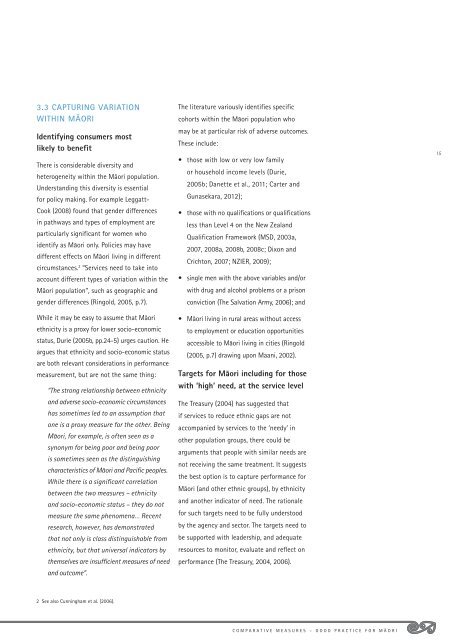Measuring performance and effectiveness for Mäori ... - Te Puni Kokiri
Measuring performance and effectiveness for Mäori ... - Te Puni Kokiri
Measuring performance and effectiveness for Mäori ... - Te Puni Kokiri
You also want an ePaper? Increase the reach of your titles
YUMPU automatically turns print PDFs into web optimized ePapers that Google loves.
3.3 CAPTURING VARIATION<br />
WITHIN MÄORI<br />
Identifying consumers most<br />
likely to benefit<br />
There is considerable diversity <strong>and</strong><br />
heterogeneity within the Mäori population.<br />
Underst<strong>and</strong>ing this diversity is essential<br />
<strong>for</strong> policy making. For example Leggatt-<br />
Cook (2008) found that gender differences<br />
in pathways <strong>and</strong> types of employment are<br />
particularly significant <strong>for</strong> women who<br />
identify as Mäori only. Policies may have<br />
different effects on Mäori living in different<br />
circumstances. 2 “Services need to take into<br />
account different types of variation within the<br />
Mäori population”, such as geographic <strong>and</strong><br />
gender differences (Ringold, 2005, p.7).<br />
While it may be easy to assume that Mäori<br />
ethnicity is a proxy <strong>for</strong> lower socio-economic<br />
status, Durie (2005b, pp.24-5) urges caution. He<br />
argues that ethnicity <strong>and</strong> socio-economic status<br />
are both relevant considerations in <strong>per<strong>for</strong>mance</strong><br />
measurement, but are not the same thing:<br />
“The strong relationship between ethnicity<br />
<strong>and</strong> adverse socio-economic circumstances<br />
has sometimes led to an assumption that<br />
one is a proxy measure <strong>for</strong> the other. Being<br />
Mäori, <strong>for</strong> example, is often seen as a<br />
synonym <strong>for</strong> being poor <strong>and</strong> being poor<br />
is sometimes seen as the distinguishing<br />
characteristics of Mäori <strong>and</strong> Pacific peoples.<br />
While there is a significant correlation<br />
between the two measures – ethnicity<br />
<strong>and</strong> socio-economic status – they do not<br />
measure the same phenomena… Recent<br />
research, however, has demonstrated<br />
that not only is class distinguishable from<br />
ethnicity, but that universal indicators by<br />
themselves are insufficient measures of need<br />
<strong>and</strong> outcome”.<br />
The literature variously identifies specific<br />
cohorts within the Mäori population who<br />
may be at particular risk of adverse outcomes.<br />
These include:<br />
• those with low or very low family<br />
or household income levels (Durie,<br />
2005b; Danette et al., 2011; Carter <strong>and</strong><br />
Gunasekara, 2012);<br />
• those with no qualifications or qualifications<br />
less than Level 4 on the New Zeal<strong>and</strong><br />
Qualification Framework (MSD, 2003a,<br />
2007, 2008a, 2008b, 2008c; Dixon <strong>and</strong><br />
Crichton, 2007; NZIER, 2009);<br />
• single men with the above variables <strong>and</strong>/or<br />
with drug <strong>and</strong> alcohol problems or a prison<br />
conviction (The Salvation Army, 2006); <strong>and</strong><br />
• Mäori living in rural areas without access<br />
to employment or education opportunities<br />
accessible to Mäori living in cities (Ringold<br />
(2005, p.7) drawing upon Maani, 2002).<br />
Targets <strong>for</strong> Mäori including <strong>for</strong> those<br />
with ‘high’ need, at the service level<br />
The Treasury (2004) has suggested that<br />
if services to reduce ethnic gaps are not<br />
accompanied by services to the ‘needy’ in<br />
other population groups, there could be<br />
arguments that people with similar needs are<br />
not receiving the same treatment. It suggests<br />
the best option is to capture <strong>per<strong>for</strong>mance</strong> <strong>for</strong><br />
Mäori (<strong>and</strong> other ethnic groups), by ethnicity<br />
<strong>and</strong> another indicator of need. The rationale<br />
<strong>for</strong> such targets need to be fully understood<br />
by the agency <strong>and</strong> sector. The targets need to<br />
be supported with leadership, <strong>and</strong> adequate<br />
resources to monitor, evaluate <strong>and</strong> reflect on<br />
<strong>per<strong>for</strong>mance</strong> (The Treasury, 2004, 2006).<br />
15<br />
2 See also Cunningham et al. (2006).<br />
C O M P A R A T I V E M E A S U R E S – G O O D P R A C T I C E F O R M Ä O R I

















